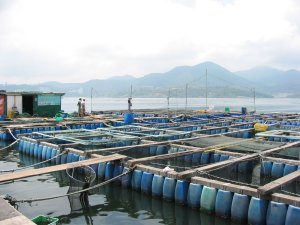|
Grow-out Systems
Traditional culture
Extensive culture of seabass as a traditional activity is followed in the Indo-pacific
region. In low lying coastal ponds, juveniles of assorted sizes collected from estuarine
areas are introduced and fed with the forage fishes like tilapia, shrimps and prawns
available in these ponds. These ponds receive water from adjoining brackishwater
or freshwater canals or from monsoon flood. Harvesting is done after 6-8 months
of culture. Since seabass exhibit differential growth, the size of the harvested
fishes varies from 0.5 to 5.0 kg. Production up to 2 ton/ha/7-8 months has been
obtained.
Cage culture
The traditional culture of seabass can be improved by stocking uniform sized seed
at specific density and feeding them with low cost trash fishes/ formulated feed.
Water quality is maintained through periodic exchange. Fishes are allowed to grow
to marketable size and harvested. Seabass culture can be done in more organized
manner as a small scale/large scale activity in both brackishwater and freshwater
ponds and also in cages.
The size of the cage may be 50 m (5 x 5 x 2 m) with mesh size depending upon the
size of the fish to be stocked (0.5 cm for 1-2 cm size fish, 1.0 cm for 5-10 cm
size fish, 2.0 cm for 20-25 cm size fish and 4 cm for fish larger than 25 cm in
size). In cage culture, both floating and stationary net cages are used.
Floating Cages
Floating cages can be set on coastal waters where tidal fluctuation is wide. The
net cages are hung on GI pipe, wooden or bamboo frames. The cage is kept afloat
by styrofoam drum, plastic carbuoy or bamboo. The most convenient dimension for
a cage is that of a rectangle and a volume of 50 m3 (5.5m × 6m
× 2m). The cage unit is stabilized with concrete weights at each bottom corner.
The cage unit has to be anchored to the bottom.

Floating cages for seabass culture
Stationary Cages
This type is fastened to wooden poles installed at its four corners. Stationary
cages are usually set in shallow bays where the tidal fluctuation is narrow. The
mesh size of nylon net would depend on the size of fish. Fingerlings should be transferred
to nylon net (mesh size of 2.0 cm) for about 2 months of culture period and then
they are moved to a cage net of 4.0 cm mesh size until harvest.
Stocking with seed of uniform size is desirable to avoid cannibalism. The stocking
density may be about 40-50 fish / m initially. However after 2-3 months of rearing,
depending upon the survival rate etc., it may be reduced to 10-20 fish/m. Periodic
transfer of fish from one cage to another is essential in order to grade the fish
and maintain uniformity in size. Feeding schedule is similar to that in pond culture.
The cages should be cleaned regularly and periodically inspected for damage. A production
level up to 15-17 kg/m can be obtained in cage culture over a period of 7-8 months.
Pond culture
The two-week nursery reared fingerlings are suitable for pond culture. The production
pond can have concrete walls and a soft bottom, ranging in area from 0.1 ha to a
few ha, water depth of up to 2 m and salinity of 5-10 ppt is suitable. Seabass culture
in ponds can be carried out either by polyculture method or by feeding with low
cost fishes like tilapia/oil sardines or with extruded floating pellets. The pond
is at first dried, tilled, leveled and manured with raw cow dung @ 1000 kg/ha. If
required, lime is added @ 50-200 kg/ha to maintain soil pH above 7. Urea @ 100kg/ha
and super phosphate @ 50 kg/ha can also be added to enhance the algal bloom. Sea
water/fresh water is then filled to a depth of 60-70cm in the pond. When the pond
water becomes light green in colour indicating sufficient development of algae in
the pond, forage fishes are introduced.
In pond culture, stocking with seed of uniform size (5-10 g), @ 3000-5000 nos./ha
is desirable. Feeding of fish is carried out following two methods. In the first
method, the fish are fed exclusively with chopped trash fish @ 10% of biomass twice
daily (08.00 & 17.00 hrs) and reduced to 5% subsequently. In the other, the
food is made available in the pond in the form of forage fish like Tilapia (Oreochromis
mossambicus). Pelletized feed can also be given. In a well-prepared pond,
manured/fertilized with raw cow dung @ 1000-1500 kg/ha and urea @ 100-150 kg/ha,
Tilapia adults (male and female in the ratio 1:3) are introduced and reared for
1-2 months prior to stocking with seabass. To maintain natural food production for
the forage fish, periodic manuring at fortnightly interval is done @ half the initial
dose. 20% of pond water is exchanged on alternate days. Harvesting is done by draining
the ponds or by using seine nets. Grow-out pond culture of seabass can yield a production
of 2-3 tons/ha within a rearing period of 7-8 months.
Harvesting
For sea bass farmed in cages, harvesting is relatively straightforward, with the
fish being concentrated into part of the cage (usually by lifting the net material)
and removed using a dip net. Harvesting sea bass 'free-ranging' in ponds is more
difficult, and requires seine-netting the pond or drain harvesting. After harvesting,
the barramundi are placed in ice slurry to kill them humanely and preserve flesh
quality. Fresh barramundi is generally transported packed in plastic bags inside
styrofoam containers with ice. There is a limited market for live barramundi in
Kerala. Fish are usually transported live in tanks by truck.
Top
|